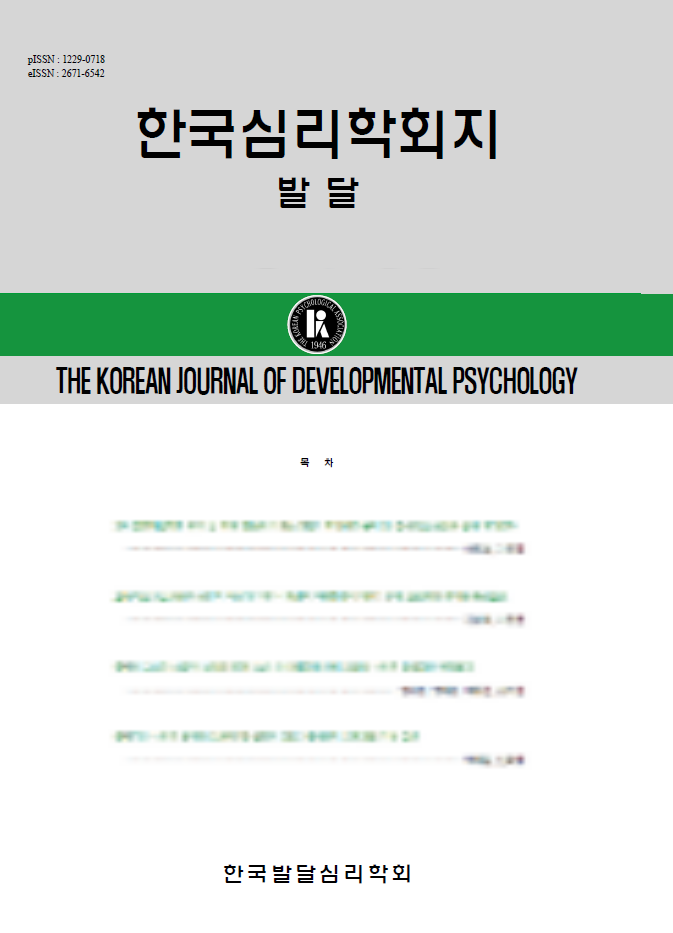open access
메뉴
open access
메뉴 ISSN : 1229-0718
ISSN : 1229-0718

본 연구에서는 의사소통 조망수용, 틀린믿음, 억제통제의 발달과 이 변인들 간의 관계를 살펴보기 위해 3세와 4세 아동 92명에게 의사소통 조망수용 산출과제와 이해과제, 틀린믿음과제, 억제통제과제를 실시하였다. 그 결과 아동들은 의사소통 조망수용 산출과제보다 이해과제에서 상대방의 조망을 더 잘 수용하였다. 또한 아동들은 특혜기반 조건보다 공통기반 조건에서 상대방 조망을 고려하여 적절한 언어를 더 많이 산출하였고, 공통기반 조건보다 특혜기반 조건에서 상대방의 조망을 고려한 반응을 더 많이 보였다. 이러한 결과는 아동들도 상대방의 조망에 민감한 것을 보여준다. 각 과제간의 관계에서 의사소통 조망수용 산출은 틀린믿음, 억제통제(낮밤과제), 수용어휘, 표현어휘와 유의한 상관을 보였다. 의사소통 조망수용 이해는 깃발과제로 측정한 억제통제와 유의한 상관을 보였다. 나아가 의사소통 조망수용에 대한 예측변인을 알아보기 위해 회귀분석을 실시한 결과, 의사소통 조망수용 산출을 예측해 주는 변인은 틀린믿음이었다. 그리고 의사소통 조망수용 이해를 예측해 주는 변인은 깃발과제로 측정한 억제통제였다. 이는 틀린믿음 이해가 높을수록 타인의 조망을 고려하여 보다 적절한 언어 사용하고, 간섭을 일으키는 자극을 억제하고 부적절한 행동을 통제하는 억제통제능력이 뛰어날수록 의사소통상황에서 상대의 관점에서 언어를 이해하는 능력이 뛰어남을 시사해준다.
In this study, we investigated children's development of communicative perspective-taking, false belief, inhibitory control, and further relations among these variables. Ninety-two 3- and 4-year-old children were tested. Children produced the appropriate adjectives in the common-ground condition more often than in the privileged-ground condition, and chose referential targets significantly more often in the privileged-ground condition than in the common-ground condition. Regression analysis revealed that false belief understanding can predict performance in communicative perspective-taking production tasks, while inhibitory control predicts performance in communicative perspective-taking comprehension tasks. This implies that children are sensitive to the perspectives of others in communication, and further, that their communicative perspective-taking ability might be partially related to false belief understanding and inhibitory control.
권은영, 이현진 (2012). 한국 아동의 속임수, 틀린믿음, 실행기능의 발달 및 상호 관계성. 한국심리학회지: 발달, 25(2), 165-184.
김영태, 홍경훈, 김경희, 장혜성, 이주연 (2009). 수용·표현 어휘력 검사. 서울: 서울장애인종합복지관.
김혜리 (1997). 아동의 마음에 대한 이해발달:틀린믿음에 대한 이해로 살펴본 마음이론의 발달. 한국심리학회지; 발달, 10(1), 74-91.
이현진 (2011). 마음이론과 실행기능의 발달및 관계: 한국아동 자료를 중심으로. 한국심리학회지: 발달, 24(4), 99-113.
이현진 (2013). 억제통제와 마음이론의 발달. 한국심리학회지: 발달, 26(1), 293-311.
이현진, Farrar, M. J., Seung, H., 김경아, 채민아, 권은영 (2008). 한국한국 아동에서 살펴본 언어와 틀린 믿음 발달 간의 관계. 한국심리학회지: 발달, 21(3), 1-20.
한유진, 강민정, 단현국 (2006). 3세와 4세 유아의 마음에 대한 이해: 틀린 믿음, 조망수용, 의도를 중심으로. 아동학회지, 27(3), 255-270.
Best, J. R., & Miller, P. H. (2010). A Developmental perspective on executive function. Child Development, 81, 1641-1660.
Bernard, S., & Deleau, M. (2007). Conversational perspective-taking and false belief attribution:a longitudinal study. British Journal of Developmental Psychology, 25, 443-460.
Carlson, S. M., & Moses, L. J. (2001). Individual difference in inhibitory control and children's theory of mind. Child Development, 72, 1032-1053.
Carlson, S. M. (2005). Developmentally sensitive measures ofexecutive function in preschool children. Developmental Neuropsychology, 28, 595-61.
Diamond, A. (1990). The development and nweural bases of higher cognitive functions. Annals of the New York Academy of Sciences, 608.
Diamond, A., & Taylor, C. (1996). Development of an aspect of executive control: Development of the abilities to remember what I said and to “Do as I say, not as I do.” Developmental Psychobiology, 29, 315-334.
Gerstadt, C. L., Hong, Y., & Diamond, A. (1994). The relationship between cognition and action:performance of children 3½-7 years old on a Stroop-like day-night test. Cognition, 53, 129-153.
Grice, H. P. (1975). Logic and conversation. In P. Cole & J. L. Morgan (Eda.). Syntax and semantics (Vol. 3, pp. 41058). New York:Academic Press.
Jones, L. B., Rothbart, M. K.., Posner, M. I. (2003). Development of executive attention in preschool children. Developmental Science, 6, 498-506.
Kohlberg, L., Yeager, J., & Hjertholm, E. (1968). Private speech: Four studies and a review of theories. Child Development, 39, 691-736.
Nadig, A. S., & Sedivy, J. C. (2002). Evidence of perspective-taking constraints in children’s on-line reference resolution. Psychological Science, 13, 329-336.
Nilsen, E. S., & Fecica, A. M. (2011). A model of communicative perspective-taking for typical and atypical populations of children. Developmental Review, 31, 55-78.
Nilsen, E. S., & Graham, S. A. (2009). The relations between children’s communicative perspective-taking and executive functioning. Cognitive Psychology, 58, 220-249.
Nilsen, E. S., & Graham, S. A. (2012). The Development of Preschoolers’ Appreciation of Communicative Ambiguity. Child Development, 83, 1400-1415.
O'Neill, D. K. (1996). Two-year-old children's sensitivity to a parent's knowledge state when making requests. Child Development, 67, 659-677.
Perner, J., Leekam, S. R., & Wimmer, H. (1987). Three-year-olds' difficulty with false belief: the case for a conceptual deficit. British Journal of Developmental Psychology, 5(2), 125-137.
Piaget, J. (1926). The language and thought of the child. London: Routledge & Kegan Paul.
Piaget, J. (1959). Judgment and reasoning in the child. Paterson: Littlefield, Adams & Co.
Reches, M., & Pérez Pereira, M. (2007). Referential communication abilities and theory of mind development in preschool children. Journal of Child Language, 34, 21-52.
Reed, M., Pien, D. L., & Rothbart, M. K. (1984). Inhibitory self-control in preschool children. Merrill-Palmer Quarterly, 30, 131-47.
Rothbart, M. K., & Posner, M. (1985). Temperament and the development of self-regulation. In L. C. Hartlage & C. F. Telzrow(Eds.), The neuropsychology of individual differences: A developmental perspective(pp. 93-.123). New York: Plenum.
Shartz, M,. & Gelman, R. (1973). The development of communication skills: Modifications in the speech of young children as a funciton of the listener. Monographs of the Society for Research in Child Development, 38(5, Serial No. 152).
Talwar, V., & Lee, K. (2002). Development of lyong to correlates of children's lying behavior. Child Development, 74(4), 866-881.
Wellman, H. M., & Bartsch, K. (1988). Young children’s reasoning about beliefs. Cognition, 30, 239-277.
Wellman, H. M., Cross, D., & Watson, J. (2001). Meta-analysis of theory of mind development:the truth about false belief. Child Development, 72, 191-214.
Wimmer, H., & Perner, J. (1983). Beliefs about beliefs: representation and constraining function of wrong beliefs in young children's understanding of deception. Cognition, 13(1), 103-128.
